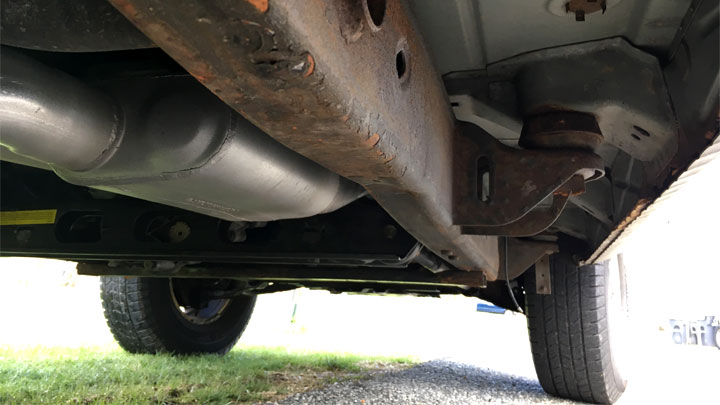Last Updated on July 15, 2021
In a perfect world, we would spend our entire lives driving from point-A to point-B, without any fear of being involved in a collision. Unfortunately, wrecks do occur across our nation’s roadways on a frequent, and unceasing basis. When such collisions occur, our vehicles often bear the brunt of our misfortune.
If lucky, a minor fender bender will result in little more than a few cosmetic defects, all of which can be repaired with relative ease. It may be as simple as pulling out a dent or repainting a bumper.
However, on the other end of the spectrum, the most violent of collisions often leave behind substantial mechanical damage, which is far more difficult to remedy (or even see).
Of this damage, none is as major as that which extends to a vehicle’s frame. When frame damage occurs, a vehicle’s chance of being totaled out skyrockets, as this often serves as the proverbial nail in the coffin for all but the newest of vehicles. However, one is often left to ponder just how bad such damage can truly be.
Read on to learn more about the seriousness of structural damage to a car, truck, or SUV’s frame, as well as the typical costs associated with repairing such damage.
What is a Car Frame?
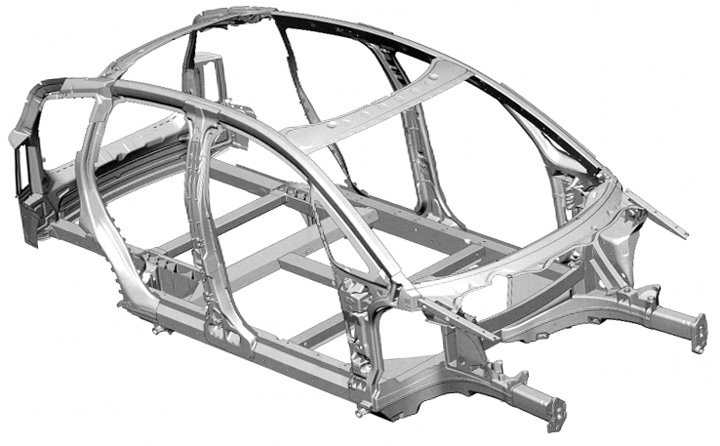
A car frame serves as the very foundation on which the rest of a vehicle is constructed. A “frame” essentially consists of two main rails, which run the entire length of a vehicle and are attached by a number of cross members at varying intervals.
While the exact design of a vehicle’s frame often varies from one particular make and model to the next, all serve the same purpose. From a vehicle’s body, to its drivetrain components, all are affixed to this central framework at one particular point within its construction.
A vehicle’s body is mounted to the frame below, via specialty body mounts. Both a vehicle’s engine and transmission are held in position by frame supported mounts. Essentially, without a well designed frame, a vehicle would simply not exist.
Vehicle frames are also carefully designed to incorporate specific angles, which ultimately influences such characteristics as driveline inclination and front-end geometry. The slightest variance in these angles can present a host of driveability-related issues.
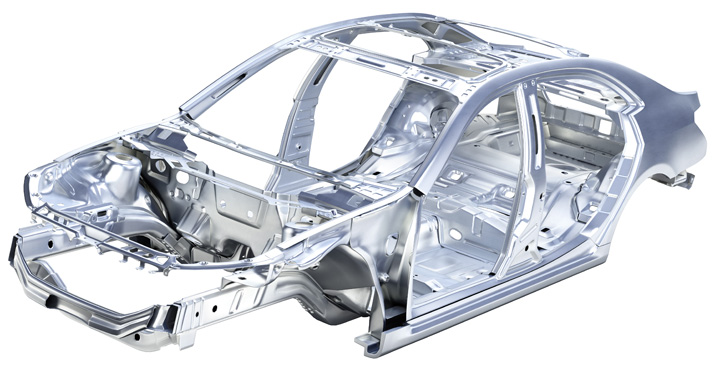
What is Considered Frame Damage?
Any damage that extends to a vehicle’s main support structure, or compromises a vehicle’s structural damage is classified as frame damage.
The most common example of this form of damage is that which results in a bent frame. This occurs when a blow suffered during a collision is substantial enough to distort a vehicle’s main support structure.
Damage to any point of mount that is permanently riveted or welded to a vehicle’s frame, can also be classified as frame damage. This includes damage that extends to a vehicle’s upper suspension mounts or crossmember mounting flanges.
Signs of a Car With Frame Damage
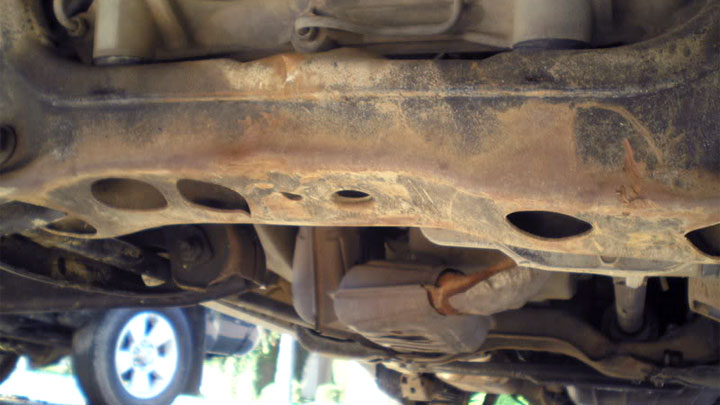
When considering the purchase of a used car, there are several tell-tale signs of frame damage that every prospective buyer should be aware of. The following are several key characteristics of frame damage to look out for.
#1 – Non-Uniform Bends In Frame
In most cases, if a bend in one frame rail does not match that of the rail on the vehicle’s opposite side, frame damage is to be suspected.
Most manufactured bends in frame rails are identical from one side of a vehicle to the next are identical, and extremely uniform in appearance.
#2 – Drastically Altered Alignment
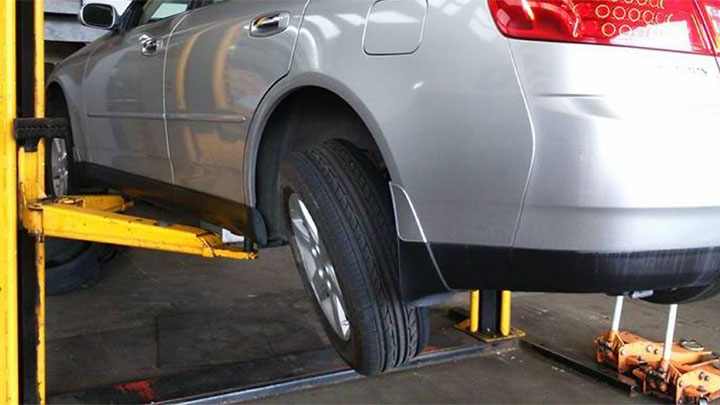
A vehicle’s front end can become misaligned for a number of reasons. However, drastic misalignment, which is highly visible by the naked eye is typically a dead give away of frame damage.
Do not be fooled into believing a seller’s claims that the vehicle in question will be fine after a quick alignment.
Related: Symptoms of a Bad Alignment
#3 – Unnaturally Positioned Suspension Components
If a quick glance inside a vehicle’s wheel well reveals a shock or strut that is canted at an unnatural angle, which does not match that at the opposing end of the same axle, take your business elsewhere.
Unnaturally positioned or misaligned shocks/struts serve as an indicator that substantial frame damage has altered the location of a vehicle’s suspension mounting points.
#4 – Ill-Fitting Components
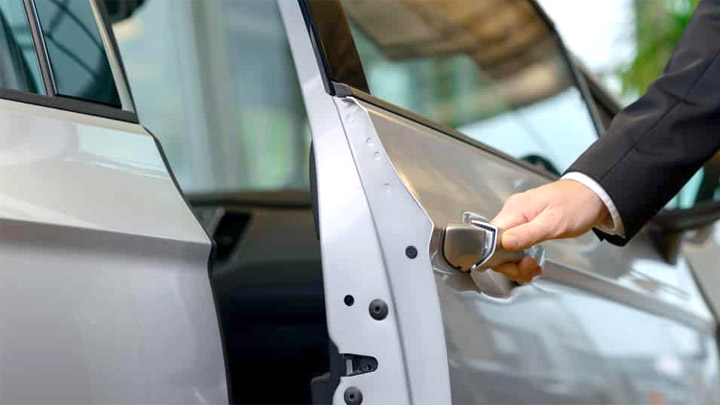
If a number of a vehicle’s body panels and accompanying components appear to exhibit a poor level of fit and finish, there is a good chance that substantial frame damage is to blame. Even a door that won’t properly close can sometimes be a giveaway that there are more serious issues at hand.
This is especially true if all of these panels and components appear to be new but bind awkwardly when moved. In many instances, a vehicle’s frame has been distorted to the point of altering the location of its body mounts.
#5 – Irregular Tire Wear
Tires can wear regularly for a number of reasons. However, if several different wear patterns are exhibited amongst tires of the same vehicle, there is a high probability that frame damage is to blame.
When a frame has been damaged to the point of altering its geometry, a vehicle’s tires will often track irregularly when traveling down the road. This almost always leads to extremely odd tread wear.
Can Frame Damage Be Fixed or Is the Car Totaled?

The viability of car frame repair is dictated by the extent of the damage that has been suffered. In certain cases, when such damage is relatively minor, a vehicle’s frame can indeed be repaired.
However, in other more severe instances, frame damage is completely irreconcilable.
When frame damage is severe enough that a substantial amount of time, effort, and money must go into completing necessary repairs, doing so is not always feasible, nor safe.
Not only would the expense associated with these repairs likely exceed that of most vehicles in their entirety, but a previously repaired frame is never as strong as it was prior to being damaged.
As a result, even if a frame could be repaired, doing so presents an enormous liability. For this reason, many shops quickly veto the idea of repairing any frame that is deemed to be excessively tweaked or distorted.
Related: What is a Branded Title?
Frame Damage Repair Cost
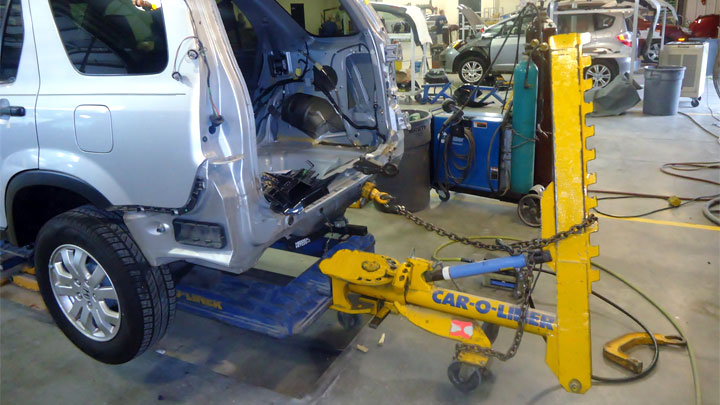
The cost associated with frame damage repair can vary significantly from one end of the spectrum to the other, and is largely reflective of the severity of such damage.
In almost every instance, a vehicle will have to be placed on a specialized piece of equipment known as a frame rack, by which precise repairs can be made. Services of this nature are never cheap, and typically require some time to complete.
At the lowest end of the price is damage that is contained to suspension mounts, which are generally riveted/welded in place at the factory. Even repairs of this type can be quite costly, and often command labor costs in the range of $1000-$2000.
Worse yet, is the fact that this estimate does not include the cost associated with fixing additional cosmetic damage that will have also occurred during such a collision.
At the other extreme of this price range is the cost which pertains to repairing a severely damaged or twisted frame. It is not uncommon for repairs of this type to exceed $10,000 in cost, before the replacement of external cosmetic components.
Few cars undergo such extensive repairs, as doing so is rarely feasible.
Is It Safe to Drive a Vehicle With Frame Damage?

Simply put, it is not ever safe to drive a vehicle with unrepaired frame damage. When such damage occurs, a vehicle’s structural integrity has been compromised. As a result, a subsequent collision of any type could lead to dire consequences.
Additionally, because frame damage often alters a vehicle’s front end geometry, driveability typically suffers. This can lead to unbalanced steering, as well as uneven weight distribution, both of which can increase the odds of finding yourself in a wreck of one type or another.
If this is not compelling enough, it is also important to understand that you might be held liable if you were to injure another motorist in a wreck, while knowing operating a vehicle with unrepaired frame damage.
As a result, you could be jeopardizing the livelihood of multiple people by driving a vehicle that has been damaged in such a manner.
Can You Sell a Car With Frame Damage?
The legality of selling a frame damaged vehicle generally differs from state to state. However, in almost every instance a seller is legally required to disclose details pertaining to such damage prior to sale. Failing to disclose this information can quickly land you on the receiving end of a lawsuit.
Furthermore, the non-disclosure of frame damage when selling a vehicle can also land you in hot water civilly, and perhaps criminally, if the vehicle’s new owner were to be injured in a collision related to such damage.
In essence, providing potential buyers with a detailed account of any known frame damage is not only the best way to proceed, but truly the only route worth taking.

